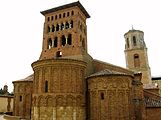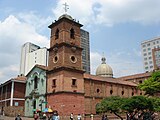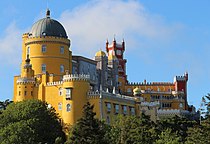Mudéjar art

Mudéjar art, or Mudéjar style, was a type of ornamentation and decoration used in the Iberian Christian kingdoms, primarily between the 13th and 16th centuries. It was applied to Romanesque, Gothic and Renaissance architectural styles as constructive, ornamental and decorative motifs derived from those that had been brought to or developed in Al-Andalus.[1] These motifs and techniques were also present in the art and crafts, especially Hispano-Moresque lustreware that was once widely exported across Europe from southern and eastern Spain at the time.
The term Mudejar art was coined by the art historian
The Mudéjar decorative elements were developed in Iberia specially in the context of historic architecture. There was a revival in the late-19th and the early-20th-century Spain and Portugal as Neo-Mudéjar style.
Etymology
Muslims in medieval Christian kingdoms
The Muslims living in the medieval Christian kingdoms of the
What allowed Mudejar culture to survive and flourish in the medieval Christian kingdoms depended upon whether the capture by Christians was accomplished through negotiated surrender or military defeat, the ratio of Muslim to Christian populations, the competing interests of the monarchy and the papacy, and economic exigencies.[citation needed] With a balance of these things, Mudejar art was born.[6] As a result of this local variation, the Islamic influences that were absorbed into the Christian architectural practices of the different regions in the Christian kingdoms differed greatly, but all come under the general umbrella term of Mudejar art.[7]
Mudéjar style in architecture

Mudejar style in architecture refers to the application of decorative Islamic art styled motifs and patterning to Christian styles of architecture. It is thought to have begun with Muslim craftsmen who applied traditional constructive, ornamental, and decorative elements derived from the Islamic arts to Christian styles of architecture. These methods became part of local Christian building traditions and were applied to Romanesque, Gothic, and Renaissance architectural styles in the expanding Christian kingdoms of Iberia.[8] These decorative techniques included calligraphy, intricate geometry, and vegetal forms derived from Islamic art and architecture.[9]
Mudejar constructive systems were very simple and extremely effective. The materials used included brick, along with other artificial stone materials, and wood, which were not only entrusted with a constructive function but which were also decorative.[7] Brick held great importance as a material of construction, its maneuverability and resistance, aesthetic characteristics and inexpensive nature, made it suitable for architecture that needed to be built in a timely fashion.[10]

Mudejar decoration and ornamentation includes stylized calligraphy and intricate geometric and vegetal forms. The classic Mudéjar elements include the
Iberian Peninsula
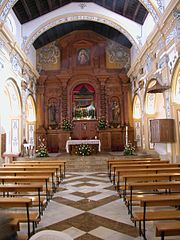

With the re-establishment of Christian rule throughout the formerly Muslim controlled areas of Iberia came the different Mudéjar construction methods for creating a building using inexpensive materials like brick, wood, and stucco.
Mudéjar art emerged in the north-eastern Christian
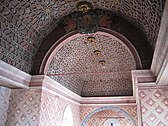
Portugal commissioned fewer Mudéjar decorated buildings, which generally incorporated simpler Mudéjar elements. The Church of Castro de Avelãs in Braganza features classic Mudéjar art brick work. Mudéjar also tended to be applied to the gothic Manueline style in Portugal, which was very lavish and ornate.[14] Portuguese use of Mudéjar art developed particularly in the 15th and 16th centuries, and structures such as the Palace of the Counts of Basto and the Royal Palace feature characteristic wooden Mudéjar roofs that are also to be found in some churches in towns such as Sintra and Lisbon. Since trade was an essential part of Portugal's culture in the 16th century, imported Mudéjar art decorated tiles from Seville appear in churches and palaces, such as the Royal Palace of Sintra.[15]
Hispanic America
Christian builders and craftsmen carried Mudéjar style elements to the overseas territories of the Spanish empire, especially in the 16th century, complementing Renaissance architecture before the emergence of Baroque.[16] The Mudéjar "style" in architecture is most accurately described as a “common visual language” rather than a cohesive structure with particular regulations. This led to Mudejar design themes in the New World to be considered purely a continuation of an architectural blend that was unique to Spain.[17]
The Church of San Miguel in Sucre, Bolivia, provides an example of Mudéjar in Hispanic America with its interior decorations and the open floor plan. Mudéjar geometric design can be seen through its octagonal patterned wood ceiling and in the underside of the supporting arches, which are carved with a vegetable motif based on the arabesque. San Miguel is a direct inheritor of the Mudéjar and tradition of the expansion and multiplication of an initial pattern. Around the octagonal dome, there are more wooden ceiling panels carved with the same pattern as the church's ceiling.[18] Additionally, the white stucco walls demonstrate the Baroque influence on the church exemplifying the transculturation found in Spanish architecture.
Some other notable examples of Mudejar design in Hispanic America are:
- The
- The Iglesia del Espíritu Santo in Havana, Cuba.[citation needed]
- Other examples of Mudéjar art can be found in Coro, a UNESCO World Heritage Sitein Venezuela.
Gallery
-
San Tirso inLeón), Spain
-
Church of Castro de Avelãs, mudéjar romanesque, 13th and 14th centuries, Bragança, Portugal
-
A mudéjar gothic cloister, La Iglesia de San Pedro, Teruel, Spain
-
The Royal Alcázars of Seville, Spain, built in the 14th to the 18th centuries, with mudejar applied to gothic, renaissance and baroque structures
-
Gallery of Dames, Royal Palace of Évora, 16th century, mudéjar manueline, Portugal
Mudéjar style in other arts
Decorative arts


Mudejar artisans brought into the Christian kingdoms the elaborate geometric designs found in tilework, brickwork, wood carving, plasterwork, ceramics, and ornamental metals of Al-Andalus. Objects, as well as ceilings and walls, were often decorated with rich and complicated designs, as Mudéjar artists were not only interested in relaying wonder, a key feature of Islamic art and architectural traditions, but in conveying the sumptuousness of materials and ornament.[20] Many decorative arts were applied to architecture, such as the tiling and ceramic work, as well as carving practices.[21]
To enliven the surfaces of wall and floor, Mudéjar art developed complicated tiling patterns. The motifs on tile work are often abstract, leaning more on vegetal designs and straying from figural images (which is common in Islamic work). The colors of tile work of the Mudéjar period are much brighter and more vibrant than other European styles. The production process was also typical of techniques that had been used in Islamic Iberia, the tile was fired before it was cut into smaller, more manageable pieces. This approach meant that the tiles and glaze work shrank less in the firing process, and retained their designs more clearly. This allowed the tiles to be laid closer together with less grout, making the compositions more intricate and cohesive.[21]
Ceramics
Ceramics had been a sophisticated art form during the period of Islamic rule in the Iberian Peninsula and Mudéjar style ceramics were built on the techniques developed in the previous centuries of Islamic art.
Neo-Mudéjar
Mudéjar art has had modern revivals, the most important in Spain and Portugal being Neo-Mudéjar that appeared in the late 19th and early 20th centuries. It combined modern architecture and materials, including cast iron and glass with Mudéjar art styled arches, tiling, and brickwork.[25]
Some Spanish architectural firms have turned their attention to building projects in the modern Arabic-speaking world, specifically Morocco, Algeria, and Eastern Arabia, where Mudéjar art influences are commissioned as a preferred style of housing. Mudéjar characteristics continue to act as a foundation for modernizing styles. Muslim architects are also currently making great strides in terms of modern architecture, reflecting the technical and engineering feats, as well as aesthetic expertise, reminiscent of the Mudéjar styles.[26]

See also
- Artesonado
- Mudéjar Architecture of Aragon
- Moorish Revival architecture
- Walls of Cuéllar
- Azulejo
References
- ISBN 84-376-1801-0.
- ^ "Mudejar Architecture of Aragon".
- ISBN 978-0-226-31963-6.
- ^ Harvey 1992, p. 4.
- ^ Jones, L.G. (2009). Encyclopedia of Islam. Facts on File. pp. 486–487.
- ^ Jones, L.G. (2009). Encyclopedia of World Religions. Encyclopedia of Islam. Facts on File. pp. 486–487.
- ^ .
- .
- .
- ^ Centre, U. "Mudejar Architecture of Aragon". UNESCO. Retrieved November 30, 2020.
- .
- ^ Chalmeta, P. (2012). "Mudéjar", in: Encyclopaedia of Islam, Second Edition.
- ^ Garma, David de la. "Arquitectura Mudejar (ARTEGUIAS)". www.arteguias.com. Archived from the original on 2016-02-05.
- ^ "Manueline | architectural style". Encyclopedia Britannica. Retrieved 2019-05-09.
- ^ Makrickas, Augustas. "Islamic influence on western Architecture".
{{cite journal}}: Cite journal requires|journal=(help) - JSTOR 24314027.
- ISBN 9781119069218.
- ISSN 2153-5914.
- ^ "Basilica and Convent of San Francisco, Lima", Wikipedia, 2018-09-12, retrieved 2019-03-09
- ^ Saba, Matthew (2012). "Abbasid Lusterware and the Aesthetics of 'ajab". Muqarnas: An Annual on the Visual Cultures of the Islamic World. 29: 187–212.
- ^ .
- ^ "Mudejar | Spanish Muslim community". Encyclopedia Britannica. Retrieved 2019-03-09.
- ^ "Discover Islamic Art Virtual Exhibitions: Mudéjar Art". Museum With No Frontiers. Retrieved 16 November 2020.
- ^ "La Cerámica Mudéjar". www.arteguias.com. Retrieved 2019-03-09.
- OCLC 655671274.
- ^ Gonzalez, Elena. “Spanish Architecture in the Arab World.” Andalusi and Mudejar Art in Its International Scope: Legacy and Modernity, 9 Sept. 2015, pp. 197–211.
Bibliography
- ARTEHISTORIA, director. El Arte Mudéjar. YouTube, YouTube, 17 June 2008, www.youtube.com/watch?v=xLuE7w1Zszo.
- Boswell, John (1978). Royal Treasure: Muslim Communities Under the Crown of Aragon in the Fourteenth Century. Yale University Press. ISBN 0-300-02090-2
- Borrás Gualis, G. (2006). Mudéjar: An Alternative Architectural System in the Castilian Urban Repopulation Model. Medieval Encounters, 12(3), 329–340. https://doi.org/10.1163/157006706779166075
- Britannica, The Editors of Encyclopaedia. "Manueline | architectural style". Encyclopedia Britannica. Retrieved 2019-05-09.
- Britannica, The Editors of Encyclopaedia. “Mudejar.” Encyclopædia Britannica, Encyclopædia Britannica, Inc., 20 July 1998, www.britannica.com/topic/Mudejar.
- Centre, U. (n.d.). Mudejar Architecture of Aragon. Retrieved November 30, 2020, from https://whc.unesco.org/en/list/378/
- Chalmeta, P., “Mudéjar”, in: Encyclopaedia of Islam, Second Edition, Edited by: P. Bearman, Th. Bianquis, C.E. Bosworth, E. van Donzel, W.P. Heinrichs. Consulted online on 30 October 2020 <https://referenceworks-brillonline-com[permanent dead link].
- Cummins, F. (2017). Mudéjar Americano. In A Companion to Islamic Art and Architecture (pp. 1023–1050). John Wiley & Sons, Inc. https://doi.org/10.1002/9781119069218.ch39
- Encyclopedia. "Art in Spain and Portugal | Encyclopedia.com". www.encyclopedia.com. Retrieved 2019-05-09.
- Garma, David de la. “Mudéjar Ceramics.” Arte Celta (ARTEGUIAS), 2012, www.arteguias.com/ceramica-mudejar.htm.
- Gonzalez, Elena. “Spanish Architecture in the Arab World.” Andalusi and Mudejar Art in Its International Scope: Legacy and Modernity, 9 Sept. 2015, pp. 197–211.
- Harvey, L. P. (1 November 1992). Islamic Spain, 1250 to 1500. University of Chicago Press. ISBN 978-0-226-31962-9.
- Harvey, L. P. (16 May 2005). Muslims in Spain, 1500 to 1614. University of Chicago Press. ISBN 978-0-226-31963-6.
- King, Georgiana Goddard. Mudejar. Longmans Ed, 1927.
- Linehan, P. (Ed.), Nelson, J. (Ed.), Costambeys, M. (Ed.). (2018). The Medieval World. London:Routledge, https://doi.org/10.4324/9781315102511
- Jones, L. G. (2009). Mudejar. In J. E. Campo, J. G. Melton (Ed.), Facts on File Library of Religion and Mythology: Encyclopedia of World Religions. Encyclopedia of Islam (pp. 486–487). Facts on File. https://link.gale.com/apps/doc/CX1692200398/GVRL?u=txshracd2598&sid=GVRL&xid=8772a220
- Makrickas, Augustas. “Islamic Influence on Western Architecture.” Academia.edu, 2013, www.academia.edu/5789655/Islamic_influence_on_western_Architecture.
- Menocal, Maria Rosa (2002). "Ornament of the World: How Muslims, Jews, and Christians Created a Culture of Tolerance in Medieval Spain". Little, Brown, & Co. ISBN 0-316-16871-8
- Museum With No Frontiers. (2004). Discover Islamic Art Virtual Exhibitions: Mudéjar Art. Retrieved November 16, 2020, from http://islamicart.museumwnf.org/exhibitions/ISL/mudejar_art/?lng=en
- Rubenstein, Richard (2003). "Aristotle's Children: How Christians, Muslims, and Jews Rediscovered Ancient Wisdom and Illuminated the Middle Ages." Harcourt Books. ISBN 0-15-603009-8
- Saba, Matthew. "Abbasid Lusterware and the Aesthetics of 'ajab." Muqarnas: An Annual on the Visual Cultures of the Islamic World 29 (2012): 187-212
- Sanz, A. (2018). Historical and Structural Aspects of the Mudéjar Architecture of the Spanish City of Guadalajara. In 10th International Symposium on the Conservation of Monuments in the Mediterranean Basin (pp. 415–423). Springer International Publishing. https://doi.org/10.1007/978-3-319-78093-1_44
- “Scattering Seeds from the Garden of Allah.” Teposcolula Retablo, 2000, interamericaninstitute.org/work_in_progress.htm.
- Sheren, I. (2011). Transcultural Architecture: Mudéjar's Epic Journey Reinterpreted. Contemporaneity (Pittsburgh, PA), 1, 137–151. https://doi.org/10.5195/CONTEMP.2011.5
- Time Out. “Architecture.” TimeOut Madrid, Time Out Guides, 2010, pp. 32–34.
- Voigt. “Tile Style.” Moorish Tile History, 1 Jan. 1970, letstalktile.blogspot.com/2011/01/moorish-tile-history.html.
- Wacks, David A. Cultural Exchange in the Literatures and Languages of Medieval Iberia. 30 Oct. 2013, davidwacks.uoregon.edu/tag/aljamiado/.

